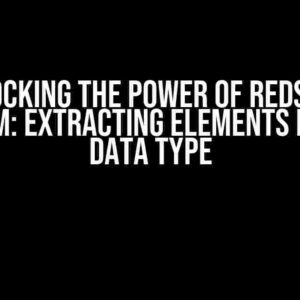Are you tired of dealing with cumbersome data structures and slow performance in your data analysis pipeline? Look no further! Arrow ChunkedArray is here to revolutionize the way you work with large datasets. In this comprehensive guide, we’ll dive into the world of Arrow ChunkedArray and show you how to get categories with ease. Buckle up and let’s get started!
What is Arrow ChunkedArray?
Before we dive into the nitty-gritty of getting categories, let’s take a step back and understand what Arrow ChunkedArray is. Arrow ChunkedArray is a columnar storage format designed for high-performance data processing. It’s part of the Apache Arrow project, a cross-language development platform for in-memory data processing.
ChunkedArray is a fundamental data structure in Arrow, which allows you to store and manipulate large datasets efficiently. It’s essentially a contiguous array of values, divided into smaller chunks, making it possible to process massive datasets in a fraction of the time.
Why Use Arrow ChunkedArray?
So, why should you care about Arrow ChunkedArray? Here are just a few compelling reasons:
- Faster data processing**: Arrow ChunkedArray enables blazing-fast data processing, making it an ideal choice for big data analytics.
- Efficient memory usage**: ChunkedArray stores data in a compressed format, reducing memory usage and making it suitable for large datasets.
- Flexible data structure**: Arrow ChunkedArray supports a wide range of data types, including integers, floats, strings, and more.
- Cross-language compatibility**: Arrow ChunkedArray is designed to work seamlessly with multiple programming languages, including Python, Java, and C++.
Getting Categories with Arrow ChunkedArray
Now that we’ve covered the basics, let’s dive into the main event: getting categories with Arrow ChunkedArray. In this section, we’ll explore different methods to extract categories from your ChunkedArray data.
Method 1: Using the `categories` Attribute
The simplest way to get categories is by using the `categories` attribute. This method is suitable when your ChunkedArray data has a categorical data type.
import pyarrow as pa
# Create a sample ChunkedArray
chunked_array = pa.chunked_array([[1, 2, 3], [4, 5, 6]], type=pa.list_(pa.dictionary(pa.int64(), ['A', 'B', 'C'])))
# Get categories using the `categories` attribute
categories = chunked_array.type.categories
print(categories) # Output: ['A', 'B', 'C']Method 2: Using the `unique` Method
In cases where your ChunkedArray data doesn’t have a categorical data type, you can use the `unique` method to get categories.
import pyarrow as pa
# Create a sample ChunkedArray
chunked_array = pa.chunked_array([[1, 2, 3], [4, 5, 6]], type=pa.int64())
# Get unique values using the `unique` method
unique_values = chunked_array.unique()
print(unique_values) # Output: [1, 2, 3, 4, 5, 6]Method 3: Using the `numpy` Library
If you’re working with numerical data, you can use the `numpy` library to get categories.
import pyarrow as pa
import numpy as np
# Create a sample ChunkedArray
chunked_array = pa.chunked_array([[1, 2, 3], [4, 5, 6]], type=pa.int64())
# Convert ChunkedArray to NumPy array
numpy_array = chunked_array.to_numpy()
# Get unique values using NumPy's `unique` function
unique_values = np.unique(numpy_array)
print(unique_values) # Output: [1, 2, 3, 4, 5, 6]While working with Arrow ChunkedArray, you might encounter some common errors. Here are a few solutions to get you out of trouble:
| Error | Solution |
|---|---|
| TypeError: ‘ChunkedArray’ object has no attribute ‘categories’ | Ensure that your ChunkedArray data has a categorical data type. If not, use the `unique` method or convert to a categorical data type. |
| ValueError: invalid literal for int() with base 10: ‘A’ | Check that your data is correctly formatted. Make sure to specify the correct data type when creating the ChunkedArray. |
Best Practices for Working with Arrow ChunkedArray
To get the most out of Arrow ChunkedArray, follow these best practices:
- Choose the right data type**: Ensure that you’re using the correct data type when creating your ChunkedArray. This will help optimize performance and reduce memory usage.
- Use compression**: Take advantage of compression algorithms to reduce storage size and improve data transfer speeds.
- Profile your data**: Understand the distribution of your data to optimize processing and reduce errors.
- Use the right method for getting categories**: Select the method that best suits your use case. If your data has a categorical data type, use the `categories` attribute. Otherwise, use the `unique` method or convert to a categorical data type.
Conclusion
In this comprehensive guide, we’ve explored the world of Arrow ChunkedArray and learned how to get categories with ease. By following the methods and best practices outlined in this article, you’ll be well on your way to unlocking the full potential of Arrow ChunkedArray in your data analysis pipeline. Remember to stay creative, experiment with different methods, and always keep your data tidy!
Frequently Asked Question
Get the scoop on getting categories of arrow chunked array! Here are the top questions and answers to get you started.
What is the purpose of getting categories of arrow chunked array?
Getting categories of arrow chunked array is essential to perform various data analysis tasks, such as data filtering, grouping, and aggregation. It enables you to understand the distribution of categorical values in your dataset and make informed decisions.
How do I get categories of arrow chunked array using PyArrow?
To get categories of arrow chunked array using PyArrow, you can use the `chunked_array.dictionary_keys` property. This property returns an array of unique categorical values. You can also use the `chunked_array.dictionary_get` method to retrieve the dictionary containing the categorical values.
Can I get categories of arrow chunked array for a specific column?
Yes, you can get categories of arrow chunked array for a specific column by accessing the column using its index or name and then using the `chunked_array.dictionary_keys` property or `chunked_array.dictionary_get` method.
What data types are supported for getting categories of arrow chunked array?
Getting categories of arrow chunked array is supported for categorical data types, such as string, integer, and timestamp. It’s also supported for dictionary-encoded arrays.
Are there any performance considerations when getting categories of arrow chunked array?
Yes, when getting categories of arrow chunked array, it’s essential to consider the performance implications, especially for large datasets. You can use techniques like data filtering and chunking to reduce the amount of data being processed and improve performance.


